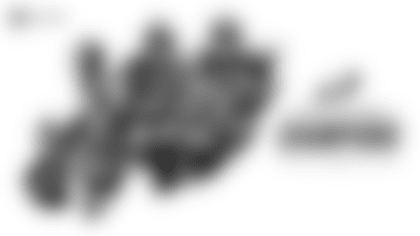A disheartening loss to Dallas was not a fun way to conclude the holiday weekend for any Eagles fan, and reliving it on Monday morning was equally as dreary, but here are my biggest takeaways after watching the film. Despite the fact that they lost by three scores to a bad Cowboys team, there were some bright spots to take away.
Offensively, a chunk of those positives came on the first two drives, where they reached the end zone on both possessions. The Eagles came out and leaned heavily on the run game to open the afternoon, with seven called rushes and five passes (a couple of which resulted in scrambles by Jalen Hurts).
It was the final run, the touchdown by Miles Sanders, that caught my eye, though. Why? Because the structure of the play felt oh so familiar. It was almost like I had seen it dozens of times before from the Eagles' offense since the turn of the century. Take a ride with me on this ...
ALL OF THE VIDEO CLIPS FEATURE AUDIO ANALYSIS
That's right – the run by Sanders was very similar philosophically to the famed "shovel pass" that led to so many trips to the end zone for the Eagles over the years. It has the same fundamental stressors for the defense.
You had horizontal expansion (the jet sweep on Sunday from Quez Watkins or the sprint-action from Donovan McNabb and Correll Buckhalter under Andy Reid).
You had pulling linemen from the back side (Jordan Mailata and Isaac Seumalo against the Cowboys, with just Todd Herremans in the 2008 clip).
Look at the seal both plays create! It's the same idea for both plays, just executed a bit differently. I thought the comparisons between the two concepts were just too good to pass up for this breakdown.
So the Eagles ran the ball a lot on that opening drive, and just like on that play, we saw a lot of offensive linemen, namely Mailata and Seumalo, pulling. So what happens on the next drive? The Eagles run play-action, with Seumalo going from left to right as a fake puller. This shot play results in an 81-yard touchdown to DeSean Jackson.
It was a well-designed play by the coaches. The players perfectly executed it. Eagles go up 14-3 and all is well in the world! The Eagles are on their way to victory and should be playing for the NFC East in Week 17 to wrap up the regular season. As we all know, that's not what happened. Why? Well, there are layers to that.
The Eagles clearly came into this game wanting to feature both the run game and the play-action pass game. Hurts lined up under center a good bit. We even saw him in the pistol, which also resulted in multiple play-action completions for nice gains.
The Eagles ran six plays out of the pistol on Sunday – after running just five plays out of that formation all season long beforehand! It was clearly a point of emphasis against the Cowboys.
The play-action pass game was an effective tool for them against Dallas, with completions of 18, 81, 19, 23, 43, and 10 yards, and just a pair of incompletions. The Eagles averaged over 5 yards per carry as well! So the run game was working. The play-action pass game was effective. What happened?!?
Look at the drives.
After scoring on their first two possessions, the Eagles went three-and-out on their final drive of the first quarter. That possession had three runs before the punt.
On the next drive, their first of the second quarter, they moved the ball into enemy territory, even getting as far as the Dallas 35-yard line. They were in striking distance for points. On second-and-9, Hurts threw a pass away while being pressured on a shot play downfield. On third-and-9, a false start penalty backed them up to the Dallas 40. Third-and-14 produced an incompletion and the Eagles punted.
The Eagles extend their lead with a field goal on the next possession, going up 17-13. This would be their last points of the game.
The last drive of the first half was kind of a throwaway in that they tried some gadgets and Hail Mary passes to attack downfield. That resulted in no points.
Coming out of the half, the Eagles went three-and-out. Two runs set up third-and-3. Hurts left the pocket and didn't see Alshon Jeffery over the middle for what would have been a first down (I'll explain why in the next clip). Eagles punt.
Dallas is now up 30-17 with just over eight minutes left in the half. Plenty of time. A first-down sack derails the drive, and the Eagles punt shortly afterward.
Same score on the next possession, and on this one they cross midfield again! A run sets up third-and-5. Hurts rolls left, doesn't like what he sees, and takes off for a couple of yards. The Eagles chose to take a delay of game penalty and punted away on fourth-and-8.
The next one is a killer. Darius Slay picks off Andy Dalton, and the Eagles get the ball down 13 at the Cowboys' 28-yard line with under a minute left in the third quarter. A score here makes it a one-touchdown game. On second-and-10, Sanders juts up the middle for 18 yards, but a holding penalty brings it back. The Eagles instead face second-and-13, which turns into second-and-18 after a false start penalty. Hurts' next pass is batted down at the line of scrimmage, which preceded another false start. That brings up third-and-23. Two passes underneath to Ertz result in a turnover on downs. Cowboys ball. Drive completely stalled because of penalties.
The Eagles moved the ball well on their next three drives, getting the ball into the red zone, but all three ended in turnovers, with a pair of picks and a fumble by Hurts running the ball. Game over.
What was the point of this? The Eagles didn't abandon the run. Watching the film, I actually thought they stuck with it until they had no choice. Penalties did them in, getting them behind the chains too often, and when you pair that with Hurts just not playing well, it was tough to move the ball offensively.
Make no bones about it. This was Hurts' worst start so far. He looked like a rookie on the road against a division rival. He left the pocket early too often, leaving some throws on the field. He misfired on some passes. This is to be expected. This is part of the growing process for young quarterbacks. It happens to all of them. This was obviously an unfortunate spot for it to happen, as the Eagles could not recover from the negative plays that plagued them too often against a porous Dallas defense.
Defensively, the Eagles flat-out lost a battle of attrition, in my opinion. They entered the game extremely shorthanded both up front and in the secondary, and additional injuries hampered them even more. They lost one of their best players in Fletcher Cox on the third possession, and the quick passing game of the Cowboys quarterbacked by a veteran in Andy Dalton carved up the Eagles' defensive backfield.
The Eagles tried to pressure Dalton early and often in this game. They blitzed him from multiple angles to try and rattle him into making a bad decision. That wasn't a bad thought because that's part of the issue that Dalton has at times ... just not on Sunday. The eight-year vet was poised, under control, and knew where to go at all times against the Eagles' pressure schemes. Time and time again, the Eagles blitzed, and he knew where to beat it.
In the second half, the Eagles dialed back on the pressure and played more coverage. When they did that, the Cowboys called plays that attacked their man coverage concepts.
Whether they did it through scheme or matchups, the Cowboys found ways to win in the passing game. The Eagles were unable to create enough consistent pressure with the ball coming out so fast, and the secondary couldn't do enough to disrupt the timing of those throws and force the quarterback to hold on to the football. The result was one of the best post-Dak Prescott performances for the Dallas offense.
A bright spot came on that Slay interception that I referenced earlier. Here's how that play happened.
Ironically enough, the interception came from a zone coverage concept, and it was an outstanding play by Slay, who undercut the route from a receiver he was not lined up across from pre-snap. He played it perfectly and then finished for a clutch interception. It was ironic because the Eagles have played so much man coverage this year, trying to utilize the lockdown nature of Slay's skill set. On this one, he came up with the pick, the first by an Eagles cornerback in 2020.
Lastly, I wanted to give Brandon Graham some love. BG was named to his first career Pro Bowl last week. How did he follow that up? With a sack (his first since the last time these two teams met in Week 8), and plays against the run and in pursuit. This is Brandon Graham every time he takes the field. He's the same player every time he steps between the lines, and it's what makes him so much fun to study as a pillar for this defense. Congrats to BG, and here's hoping he can get a couple of sacks against Washington this week for the first double-digit sack season of his career as well.
Fran Duffy is the producer of the Emmy-nominated Eagles Game Plan show which can be seen every gameday during the season on NBC10 in Philadelphia. He is also the host of two Eagles-related podcasts, Eagle Eye in the Sky, which examines the team from an X's and O's angle each and every week as well as the Journey to the Draft podcast, which covers college football and the NFL Draft all year round. Fran also authors the Eagle Eye in the Sky column, which runs four times a week during the football season to serve as a recap for the previous game and to preview the upcoming matchup. Prior to joining the Eagles in 2011, Duffy was the head video coordinator for the Temple University football team under former head coach Al Golden. In that role, he spent thousands of hours shooting, logging, and assisting with the breakdown of the All-22 film from the team's games, practices, and opponents.






















